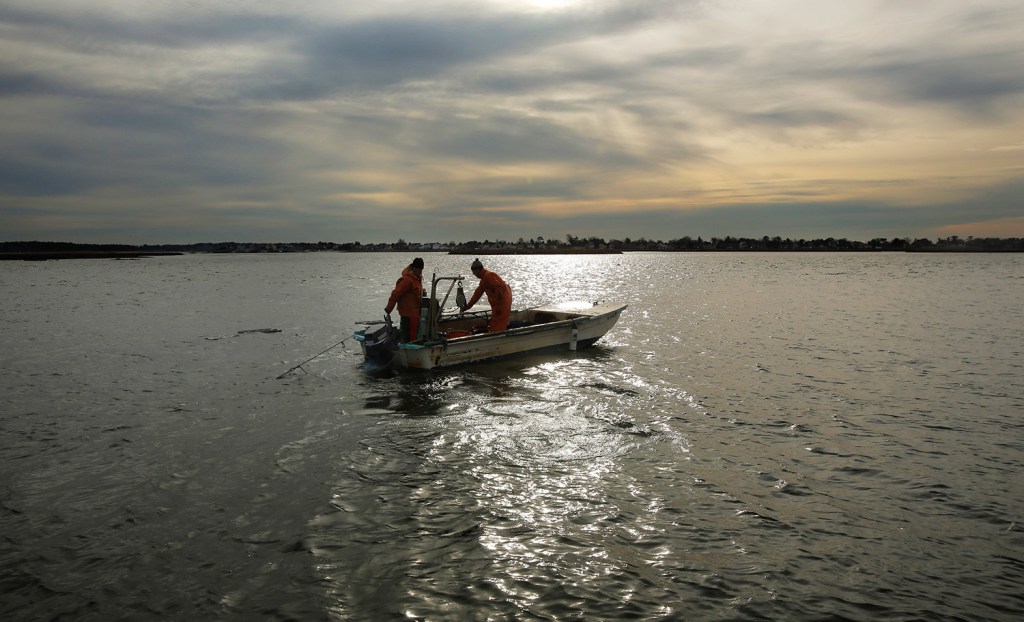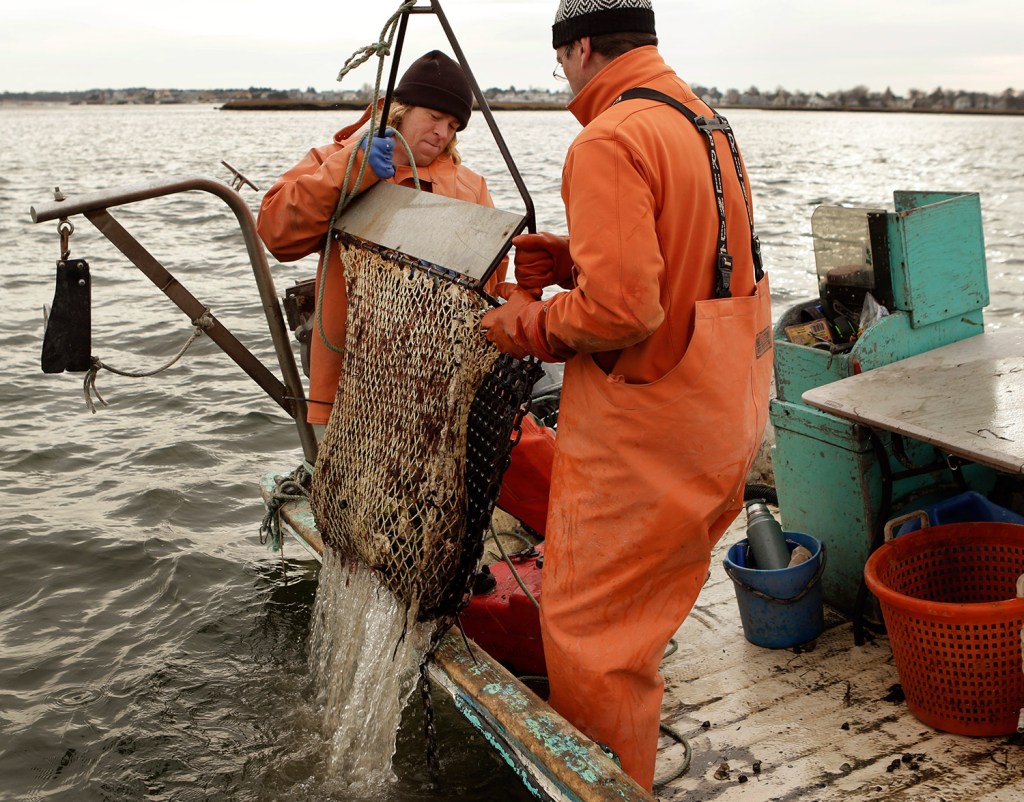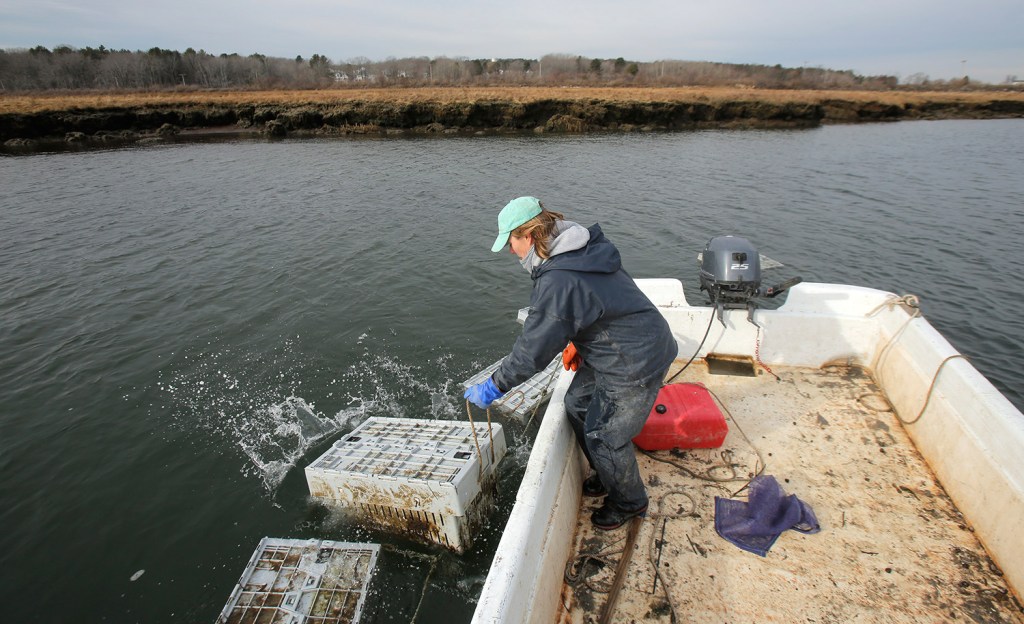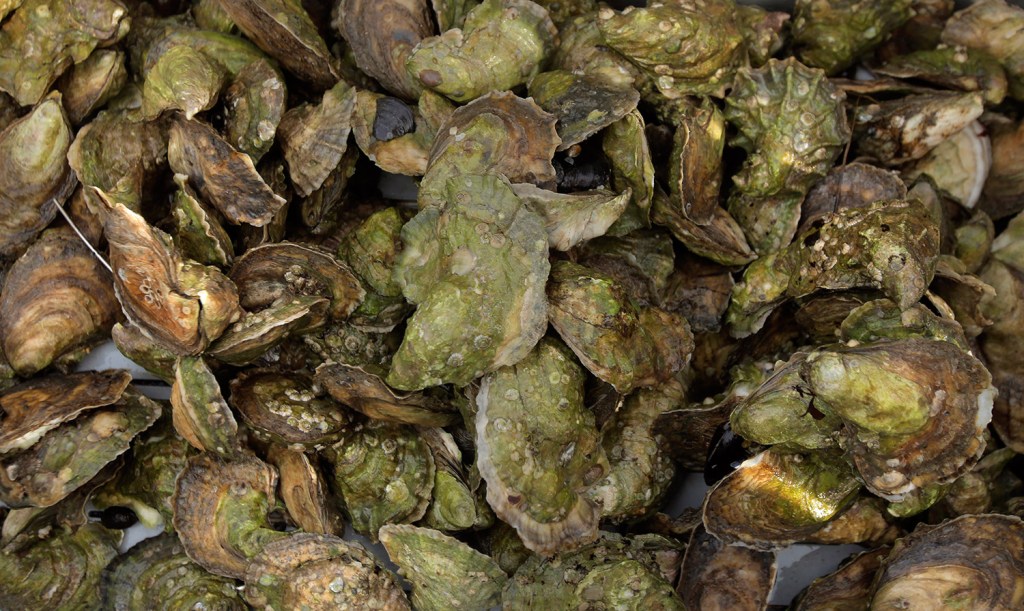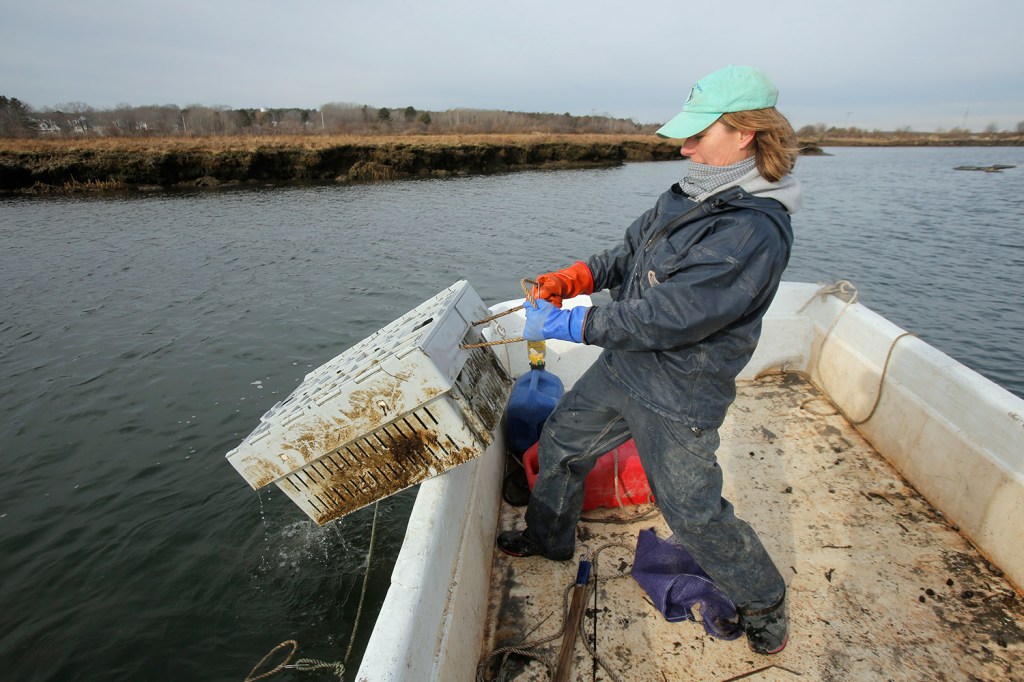SCARBOROUGH — Oyster farmer Abigail Carroll straddles her boat motor as if she were getting on a seesaw – apologizing over her shoulder for how goofy it might look – lowers her weight onto it and sinks into a deep squat, demonstrating how she uses her body to lift the propeller out of the water.
It might not be macho marine, but this is the new way she handles the motor. The old way, bending over it and using her hands and arms to lift the heavy machinery, is what got her in trouble in the first place. Last spring she was trying to yank the weight up and out of the water and the cowling (cover) came away in her hands, sending her tumbling. She landed hard on the hull, striking the bottom of her spine. “I went flying,” she said ruefully. “I was out for a week.”
The injury was muscular but it stayed with her for the summer as she hoisted one heavy dragger and/or crate full of oysters after another out of the waters of Scarborough Marsh and in the fall, after getting the flu, she was in such rough shape that a friend sent her to his physical therapist, Kenneth Simons. He came out to her 6.8-acre farm and watched Carroll and the rest of Nonesuch Oysters’ harvesters at work.
Simons has worked with a lot of home gardeners who injure themselves while tugging on something like weeds that releases suddenly and send them backwards. And he’s worked with people who do a lot of lifting in warehouses. But he observed that the oyster farmers’ set up of lifting heavy loads is particularly hard on the back. “The classic example is lifting from the floor or from pallets,” he said. “But it is never below your feet the way they are. Not to mention, their floor is moving.”
Simons came up with a list of exercises and equipment adjustments, suggestions which Carroll eagerly incorporated into her work days. “I feel like I’m trying to do things differently,” she said.
“Part of it is just being mindful,” she added, “thinking about where your center of gravity is.”
This seems to be the way of today’s new farmers. Don’t just grin and bear it, repair it. Working a farm, whether on land or on sea, is repetitive and draining work. January, when everyone you know is making health and body-related resolutions, signing up for Weight Watchers or gym memberships, is also when most farmers have some time on their hands to address the aches and pains that accumulated during the last growing season.
That could entail physical therapy, like the kind Simons practices (he’s got a lobsterman on his list of patients now as well). Or it might mean working with free programs like Maine AgrAbility, a USDA-funded program that helps those in agriculture with disabilities, chronic health conditions or simply aging- related issues.
Ellen Gibson, who works with the Maine AgrAbility Program, said they’ve made about 75 visits to Maine farms since the program started in 2010. When Gibson visits a farm for an assessment, she typically brings an occupational therapist, who she says “has the most amazing sense of what people need to be doing to make it easier on their entire body.”
Maine AgrAbility has also reached hundreds more farmers, woodsmen and ocean harvesters through public presentations, she said, including at the Common Ground Fair. Even the younger farmers she sees there are complaining about the aches and pains leftover from a summer of hard work.
Sometimes the advice she passes on is something as basic as don’t jump off the tractor, climb off it. It’s not always received well.
There’s definitely a macho aspect to it,” Gibson said. “Older farmers will just look at me and roll their eyes and say, ‘Pain is what I live with.’ And it’s like, you really don’t have to.”
NEW DOGS, NEW TRICKS
But given how much the local food movement focuses on organics and healthy living, it’s perhaps unsurprising that many of these efforts fall within the holistic healing world.
“I haven’t needed physical therapy,” said Milkweed Farm’s Lucretia Woodruff. “I have tried to stay ahead of that. I have thought, ‘whoa, farming really is hard on your body.’ But I have had acupuncture, which does seem to help.”
She’s also a yoga practioner and teacher – she has taught classes at Bowdoin College for 12 years – and uses yoga both in and off the fields, stretching out before and after a work session. “I am usually just so busy when I am farming that I am doing just that. But I try to really think about my alignment when I am squatting or kneeling.”
Milkweed apprentices are likely to get an impromptu yoga lesson in the field from Woodruff in the form of an adjustment if she sees them doing something harmful. That’s the informal class. But in Kittery, Erin Ehlers has actually taught a class called “Yoga for Farmers” four times in the last few years at the Yoga on the Hill studio. The classes have averaged seven to 10 pupils, whom she described as mostly farmers but also landscapers and dedicated home gardeners. She’ll be teaching it again this March (check her website, yogaonthehillkittery.com for schedules).
“Winter is a good time for farmers to recommit to self-care practices like yoga,” Ehlers wrote in an email. “Yoga can help prepare farmers (and gardeners and stone-masons and landscapers and construction workers) by keeping the body balanced and strong before Spring arrives.”
Ehlers is married to an organic vegetable farmer, and she spent two years working as a cheesemaker on a dairy farm, so she knows of what she speaks. “Yoga makes sure that the bad habits of hunching to lift crates or squatting without being aware of body mechanics are replaced by better habits, better posture and improved full-body strength.”
Throughout these recent dark mornings of winter, a group of farmers from Whitefield have been carpooling to a 5:30 a.m. class at a studio in Wiscasset. Ben Marcus, who farms and runs the Sheepscot General Store at Unca’s Farm in Whitefield with his wife Taryn Hammer, is part of that carpool, along with Jessie Dowling of Fuzzy Udder Creamery.
Yoga is something Marcus had done periodically over the years but not consistently. Now he’s intent on getting the most out of a 30-day trial at a studio in Wiscasset, including that 5:30 a.m. class.
“That’s hard-core, right?” Marcus said.
The classes and treatments carry over, a healthy body memory to remind him how to work smart. “It has to do with how you carry yourself during the day and paying attention to the ergonomics of what you are doing,” Marcus said.
NOT JUST FOR THE PROFESSIONALS
Home gardeners can get in on the wellness action as well. The Brunswick Topsham Land Trust is offering a class called “Gardening without Aches and Pains” on Feb. 21, taught by Gibson of the Maine AgrAbility Program (she’s also offered “Gardening Forever”). In Norway, Katey Branch of Halls Pond Healing Arts and Scott Vlaun, the director of the Center for an Ecology-Based Economy, team up for occasional yoga workshops in the community garden downtown.
“It’s a natural fit,” Vlaun said. “Especially with people like the new generation of farmers that are realizing they are going to be working a lot more with their bodies.”
Making small adjustments to the way one moves in the field might seem simple, but Vlaun said it can change the whole nature of the action. “Then the work becomes more like back-building, not back-breaking, labor. If you are doing your yoga in the off-season, not only do you have all this fitness and flexibility, you also have a better understanding of how you use your body. Maybe you find yourself in Warrior pose while you are hoeing.”
“I feel like we could just leave the gym and the yoga studio behind and so much of our exercise and fitness could come from growing food,” Vlaun added.
For someone like Carroll, who says she wishes she still had time for yoga, that’s unlikely to happen. Instead she’ll do Simons’ exercises and rejigger her equipment as needed, like heightening the davit she uses to lift her oyster dragger onto the boat so that it lands on her sorting table instead of below it.
Then in the summer, she’ll harvest in a wet suit and snorkel mask, moving through the water in the gentlest way she knows how. This gets her a big thumbs-up from Simons. “That would be a much better position,” he said. “She would be basically laid out in a comfortable position, and supported by the buoyancy of the water.”
Back-saving, in other words.
“Bending the back is the issue for most farmers,” Simons said. “And all of the material-handling kinds of issues, lifting totes or whatever they are moving their product in.”
THE NEEDLE AND THE DAMAGE UNDONE
The daily grind of “the lifting and being stressed out and making sure everything is OK and running a farm” brought Marcus not just to yoga but to acupuncture.
“I got turned on to it from another farming friend of mine who had major lower back issues,” Marcus said. One of his CSA customers was an acupuncturist, and they arranged a barter.
“She puts needles in me,” Marcus said. “I go to another place and then she comes back in like a half-hour later and basically wakes me up. And I feel like I just woke up from the best eight-hour sleep I ever had.”
He goes in the evening almost once a month in the summertime, during high-stress season. “It’s more a preventative health-care measure than anything,” he said.
The classic Maine way of winding down from a hard day on the land – or the road, or at the mill – might traditionally have involved a beer and a cigarette, but these younger Maine farmers want to take a different route, trying to preserve their strength and flexibility for long-term lives on the land.
“It is a piece of the puzzle for sure,” Marcus said.
At the Sheepscot General Store, he and Hammer have hosted yoga classes as well, but Marcus is aware of how that bucks tradition – farmers putting on yoga classes. “You know how people are,” Marcus said.
“All this holistic medicine,” he said. “It all carries this stigma with it.”
Unless you’re open to it. In which case, between ergonomics, needles and namastes, the harvest might be a lot happier.
Send questions/comments to the editors.


